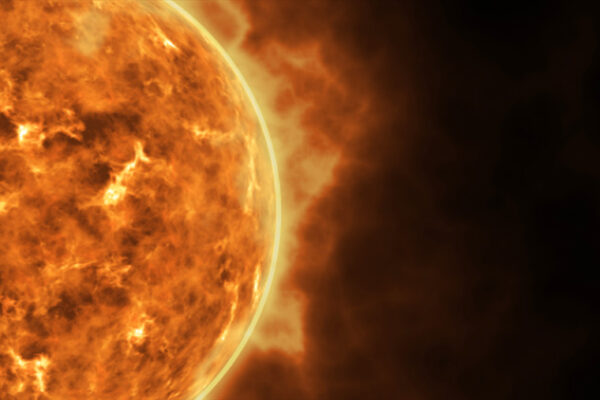Active learning to transform undergraduate education in WUSTL computer science and engineering
Timothy Trinidad leads a discussion with classmates (from left) David Schainker, Helena Wotring and Mamta Datwani. The students are part of a computer science engineering course taught by Burchan Bayazit, Ph.D., assistant professor of computer science and engineering. The course stresses “active learning,” and features group work, presentation skill and critiques.Kenneth J. Goldman, Ph.D., associate professor of computer science and engineering, is the recipient of a $562,000 grant from the National Science Foundation that will enable his department to transform undergraduate teaching methodology. Goldman and his fellow principal investigators are working to cultivate “active learning” in the classroom, with a significant increase in studio courses that involve team projects and interdisciplinary collaboration. In a culture marked by frequent critique, students will refine their design skills, as well as improve their ability to present and justify their designs and work in groups. Passive learning, typified by the traditional lecture, will be put on the backburner, though the flame will still burn low.
Discovery could increase tumors’ sensitivity to radiation therapy
Mouse embryos stained to show MOF (green) and its histone tag (red) demonstrate that MOF is essential for cell proliferation.To make tumors more sensitive to the killing power of radiation is a key aspiration for many radiation oncologists. Researchers at the School of Medicine have uncovered new information that leads them closer to that goal. In an upcoming issue of the journal Molecular and Cellular Biology, they report the first extensive study of an enzyme called MOF that helps control how DNA is packaged in cells. The researchers show that MOF is an essential factor for tumor development, and they say it may be possible to manipulate the enzyme to make tumors more sensitive to radiation therapy.
Washington University scientists analyze solar wind samples from Genesis mission
As reservoirs of valuable information go, nothing beats the sun. This sphere of heat and energy holds 99.9 percent of the solar system, saved in all original proportions after planets and meteorites formed. Analyzing the mix of hydrogen, oxygen and noble gases found in the sun can answer one of the biggest questions of the universe: How did our solar system evolve? Scientists at Washington University in St. Louis and a large team of colleagues marked the beginnings of that odyssey by examining samples of solar wind for neon and argon, two abundant noble gases. The work was published in the Oct. 19, 2007, issue of Science.
WUSTL researcher studies Methuselah of the mammals
WUSTL researcher Stanton Braude, Ph. D., lecturer in biology in Arts & Sciences, says the secret to a long life in humans might exist in the wrinkled body of one of the world’s ugliest animals — the naked mole rat.
WUSTL researcher studies Methuselah of the mammals
Washington University researcher Stanton Braude, lecturer in biology in Arts & Sciences, says the secret to a long life in humans might exist in the wrinkled body of one of the world’s ugliest animals — the naked mole rat.
After drought, ponds “keep up with the Joneses”
WUSTL senior Ruth Poland and Jonathan Chase, Ph.D., associate professor of biology and director of WUSTL’s Tyson Research Center, check species out in one of Tyson’s ponds.An ecologist at Washington University in St. Louis has discovered that after ponds dry up through drought in a region, when they revive, the community of species in each pond tends to be very similar to one another in species composition.
Botanical ‘cloak-and-dagger’
Photo by David KilperThat clover necklace you make for your child could be a ring of poison. That’s because some clovers have evolved genes that help the plant produce cyanide — to protect itself against herbivores such as snails, slugs and voles. Kenneth Olsen, Ph.D., assistant professor of biology in Arts & Sciences, is looking at the genetics of a wide variety of white clover plants to determine why some plants do and some plants don’t make cyanide. Ecology and geography play important roles.
Botanical ‘cloak-and-dagger’
Is that clover necklace you make for your child poison? It could be. Kenneth Olsen, Ph.D., Washington University assistant professor of biology in Arts & Sciences, is looking at the genetics of a wide variety of white clover plants to determine why some plants do and some plants don’t make cyanide. Ecology and geography play important roles.
WUSTL engineers find common ground in brain folding, heart development
Photo by David KilperLarry A.Taber, Ph.D., (left) the Dennis and Barbara Kessler Professor of Biomedical Engineering, and Philip Bayly, Ph.D., the Hughes Professor of Mechanical Engineering, employ a microindentation device to measure the mechanical properties of embryonic hearts and brains. The researchers are examining mechanical and developmental processes that occur in the folding of the brain’s surface, or cortex, which gives the higher mammalian brain more surface area (and more intellectual capacity) than a brain of comparable volume with a smooth surface.
Ugly duckling mole rats might hold key to longevity
Image courtesy of the BBCWhat good is longevity if you end up looking like this? WUSTL biologist Stan Braude, working on a book about the critters, says the naked mole rat is being studied for its tendency to live a long life.Who would have thought that the secrets to long life might exist in the naked, wrinkled body of one of the world’s ugliest animals? Probably not many, but current research may be leading seekers of the Fountain of Youth to a strange little beast — the naked mole rat.
Older Stories

